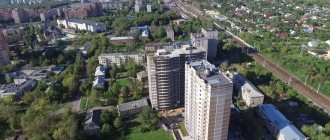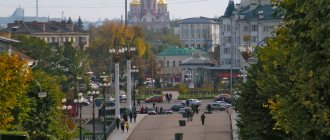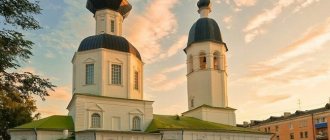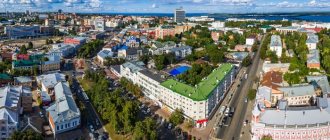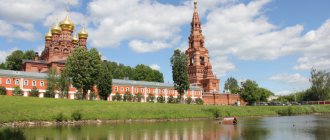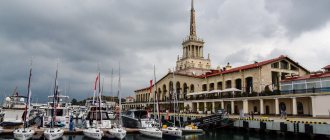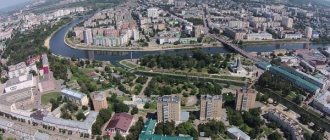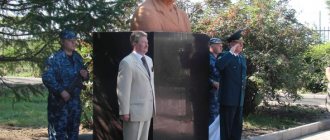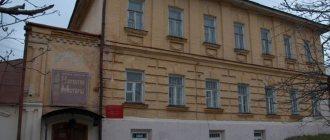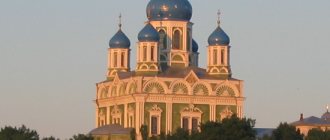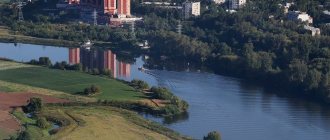This term has other meanings, see Klintsy (meanings).
| City Klintsy Flag | Coat of arms |
| A country | Russia, Russia |
| Subject of the federation | Bryansk regionBryansk region |
| Urban district | Klintsy city |
| Coordinates | 52°45′10″ n. w. 32°14′10″ E. long / 52.75278° north w. 32.23611° east. d. / 52.75278; 32.23611 (G) [www.openstreetmap.org/?mlat=52.75278&mlon=32.23611&zoom=12 (O)] (Z)Coordinates: 52°45′10″ N. w. 32°14′10″ E. long / 52.75278° north w. 32.23611° east. d. / 52.75278; 32.23611 (G) [www.openstreetmap.org/?mlat=52.75278&mlon=32.23611&zoom=12 (O)] (I) |
| Chapter | Shkuratov Oleg Pavlovich |
| Based | in 1707 |
| City with | 1925 |
| Square | 64 km² |
| Center height | 150—160 |
| Climate type | temperate continental |
| Population | ↗61,916[1] people (2016) |
| National composition | Russians, Ukrainians, Belarusians and others |
| Confessional composition | Orthodox and other denominations |
| Names of residents | Klinchane, Klinchanin, Klinchanka |
| Timezone | UTC+3 |
| Telephone code | +7 48336 |
| Postal codes | 243140—243146 |
| Vehicle code | 32 |
| OKATO code | [classif.spb.ru/classificators/view/okt.php?st=A&kr=1&kod=15415 15 415] |
| Official site | [www.klinci.ru nci.ru] |
| Klintsy Moscow |
| Bryansk Klintsy |
Audio, photo and video
on Wikimedia Commons
K: Settlements founded in 1707
Klintsy
- a city in Russia, the administrative center of the Klintsy district and the City Okrug of the city of Klintsy, Bryansk region.
The population of the city is 61,916[1] people. (2016), with suburbs - 69,391[1] people. (2016) (the second most populous city in the Bryansk region). The city is a trade and economic center of the southwestern regions of the Bryansk region.
The city is located on the Moskovka River (Turosna Kartavoy), a tributary of the Turosna River in the Dnieper basin, 172 kilometers[2] west of Bryansk, 5 km from the M13
Bryansk - Novozybkov - border of the Republic of Belarus.
The city has a railway station of the same name on the Moscow Railway (on the Bryansk - Gomel line).
Story
The settlement of Klintsy was founded in 1707 by Old Believers peasants and was named after the first settlers (Klinets) in the plural.
In 1782 Klintsy became a settlement as part of Surazhsky district. At the same time, several printing houses opened here, publishing mainly liturgical Old Believer books. The development of printing contributed to the high literacy of the population of Klintsy.
In 1782-1796. Klintsy is part of the Novgorod-Seversky governorship, and in 1796-1802. - in the Little Russian province. Since February 27, 1802, the settlement of Klintsy was in the Chernigov province, Surazh district.
Since the 1830s, textile production appeared in Klintsy, which gradually became the most important industry in the city. By the end of the 19th century, more than 90% of the textile industry of the Chernihiv region was concentrated here. The city was called "Manchester of the Chernigov province."
Electricity in Klintsy first appeared at the factory of I.P. Mashkovsky in 1886. In 1900, the settlement was electrified, there were 10 cloth factories, 3 hosiery establishments, 11 tanneries, two iron foundries, 1 linen factory, 1 oil mill, 2 soap factories, three brick factories; several branches of various banks, a post office, a telegraph office, a pharmacy and a pharmaceutical warehouse, three commission offices, five churches: Ascension and Trinity Edinoverie, Peter and Paul Orthodox, Pokrovo-Nikolsk and Preobrazhenskaya Old Believers; three synagogues. Outside the city there were two Old Believer monasteries (Krasnoborsky St. John the Baptist Monastery, or “The Strip”, and the Nikolo-Pustynsky Monastery. In 1916, Klintsy began publishing its own “Klintsy newspaper”.
In 1918, according to the Treaty of Brest-Litovsk, the city was part of the Ukrainian People's Republic, Chernigov province, Surazh district. Since July 11, 1919 - as part of the Gomel province of the RSFSR, Surazh district. Since 1921, the settlement of Klintsy became a district center within the Gomel province.
In 1925, Klintsy received city status[3]. Since January 14, 1929, the city of Klintsy was part of the Western Region of the RSFSR, where it was the center of the Klintsy Okrug and Klintsy District. Since 1936, Klintsy has been a city of regional subordination. Since October 19, 1937, the city of Klintsy was part of the Oryol region, and since July 5, 1944, it has been part of the Bryansk region.
During the Great Patriotic War, the city was occupied by Nazi troops from August 20, 1941 to September 25, 1943.
In the year of the tercentenary of its founding (2007), a monument in the form of a bell depicting the family of the city’s founder was erected at the supposed birthplace of the settlement.
Novozybkov is large by local standards
Novozybkov ranks third in terms of population in the region. As of 2022, about 40 thousand people live here. This settlement is attractive for its unusual history. It was founded in 1701, mainly Old Believers were located here.
Gradually the city grew and acquired the status of a district town. The cultural context as a place of peculiar exiles and dissidents remained. In modern history, this is emphasized by the fact that the surrounding areas were exposed to radioactive contamination as a result of the accident at the Chernobyl nuclear power plant. The exclusion zone begins 1 km west of the city.
Economy
The city is home to the Klintsovsky truck crane plant (one of the three largest Russian manufacturers of truck cranes; since 2008, in addition to truck cranes, it has been producing crawler cranes), a piston ring plant, an auto repair plant, a clothing factory, a knitting factory, a building materials plant, a telephone equipment plant, a bicycle, a joint venture soft toy enterprise "Rabbit", silicate plant, cannery, shoe factory "Clivia", twine factory (one of three in Russia), Baltcom Uni LLC (production of dairy food products). Since 1937, the Klintsovskaya CHPP has been operating in the city.
The city-forming enterprises of modern Klintsy are Klintsy silicate.
Population in the modern period
According to the first post-war census of 1950, the population of Klintsy decreased to 34,200 people, but by 1959 it had reached its pre-war size.
In the early 1960s, a crane factory was built and began operating, attracting additional labor to the city from other regions of the country, and the number of residents increased to 52,000 people in 1962.
In subsequent years, the population of Klintsy increased mainly due to natural growth and the influx of labor resources into expanding production. The maximum number of inhabitants - 72,000 people - was reached in 1987.
With the collapse of the Soviet Union, the city found itself in a period of protracted crisis. Many industrial facilities closed, and the volume of production at the city-forming enterprise sharply decreased. By 2013, the population had decreased by almost 10,000 compared to the last years of Soviet power, and reached 61,515 people.
Only in the last two years the number of residents has been growing slightly, but this trend is still unstable. In 2022, the population of Klintsy was 62,832 people.
Education, culture and sports
Educational institutions: industrial-pedagogical college, technological technical school, gymnasium, 8 secondary schools.
There is a branch of the regional local history museum in the city.
The local football club "Klintsy" plays in the championship of the Bryansk region.
The Klintsy basketball team is the current two-time champion of the Bryansk region.
There are two youth sports schools in the city (“Luch” named after V. Fridzon and Youth Sports School named after V. I. Shkurny), as well as art and music schools.
general information
The small town is the center of the district of the same name and the administrative urban district of Klintsy, Bryansk region.
Klintsy is the second largest settlement in the region. Together with the suburbs, 70,164 people live in it (2022 data). The city is the economic and industrial center of the southwest of the Bryansk region. It is located on the Moskovka River (Turosna Kartavoy), a tributary of the Turosna River.
The distance from the city to the regional center is 172 km, the M13 highway is nearby: Bryansk - the border of the Republic of Belarus. There is a railway station on the Bryansk - Gomel direction. Territory area 64 sq. km.
Attractions
- The building of the former town hall (late 18th century).
- The building of the former factory of D. S. Cherkassky (Cherkasov), later a men's gymnasium, later the city council (XIX century).
- The building of the former women's gymnasium (beginning of the 20th century).
- The building of the former men's gymnasium (beginning of the 20th century).
- The building of the former school named after Korolenko (early 20th century, now houses a military registration and enlistment office).
- Church of the Transfiguration (early 19th century).
- House of manufacturer Baryshnikov (late 19th century).
- House of manufacturer Sapozhkov (early 20th century).
- The building of the merchant meeting (beginning of the 20th century).
- Shopping arcades (Moscow grocery store) (early 20th century).
- The building of the former church of the Nikolo-Pustynsky Monastery (early 20th century).
- House of Shmeleng (XIX century).
- Old shopping arcades (early 20th century).
- Almshouse building (early 19th century).
- The building of the House of Soviets, designed by the architect A. Z. Grinberg (1927 - early 1930s).
- Church of St. Nicholas the Wonderworker (chapel of the Ascension Church), beginning. XX century.
- Church of Peter and Paul, designed by architect K. A. Ton (1848).
- Former treasury building (XIX century).
- Kaidanov's House (XIX century).
- House of the notary Chikilevsky (early 20th century).
- Country house "Vyunki" of manufacturer Sapozhkov (early 20th century) with a park (late 19th century).
Notable natives
- Barkov, Nikolai Sergeevich - Candidate of Technical Sciences, laureate of the Stalin Prize. For the development of a system for initiating a charge from explosives, the design of equipment and an automatic ignition system for the first atomic bomb, he was awarded the Order of Lenin.
- Belyaev, Evgeny Mikhailovich (1926-1994) - “Honorary Citizen of the City of Klintsy”, singer, People’s Artist of the USSR (1967).
- Bode, Alexander Adolfovich (1865-1937) - literature teacher, alleged author of the song “Holy War”.
- Vagin, Viktor Andrianovich - Hero of the Soviet Union
- Gutin, Vasily Leontievich - Hero of the Soviet Union
- Drozdov, Nikolai Fedorovich (1862-1953) - Russian and Soviet scientist in the field of design of cannon artillery systems and internal ballistics, founder of the school of artillery designers, Honored Worker of Science and Technology of the RSFSR (1940), full member of the Academy of Artillery Sciences, Candidate of Mathematical Sciences of the Russian Empire , Doctor of Technical Sciences (1938), professor, laureate of the Stalin Prize (1943). Lieutenant General of the Russian Imperial Army, Colonel General of the USSR Artillery (1944).
- Drozdov, Alexey Vasilievich (1983) - Russian all-around athlete. Bronze medalist at the 2006 European Championships in the decathlon and the 2010 World Indoor Championships in the heptathlon, European champion among juniors (2005), champion of Russia (2010, 2011).
- Zaitsev, Anatoly Grigorievich - Hero of the Russian Federation
- Shkurny Valery Ivanovich (1959-2000) - employee of the SOBR of the Ministry of Internal Affairs of Russia, deputy head of the SOBR of the department for combating organized crime at the Internal Affairs Directorate of the Bryansk Region, captain. Participant in the first and second Chechen wars. Hero of the Russian Federation (2000, posthumously).
- Josephie, Sofia (1906-1997, USA) - Russian and Soviet circus and silent film performer. In the period from 1923 to 1934, she starred in 10 films of the Goskinprom studio, of which the most significant were “The Punishment of the Princess of Shirvan” and “Savur - the Grave.” She entered the chronicles of world cinema as the star of “Little Red Devils” in the role of Dunyasha.
- Klotsvog, Felix Naumovich (1934-2012) - Russian economist, laureate of the USSR State Prize.
- Petukhov, Alexey Evgenievich (1983) - Russian skier. Bronze medalist of the 2010 Olympic Games in team sprint, world champion 2013, Honored Master of Sports of Russia.
- Plushenko, Sergei Alekseevich - Hero of the Soviet Union
- Rakhlin, Ilya Yakovlevich (1917-2002) - artistic director of the St. Petersburg State Music Hall, People's Artist of the RSFSR (1984), Honored Artist of Kazakhstan, Honored Artist of North Ossetia.
- Tatarinov, Leonid Mikhailovich - Hero of the Soviet Union
- Fridzon, Vitaly Valerievich (1985) - “Honorary Citizen of the City of Klintsy”, basketball player, player of the Russian national team.
- Valery Pavlovich Kupchinsky (1955) - Honored Master of Sports of the Russian Federation, 9-time Paralympic champion, multiple world and European champion in cross-country skiing. Honorary citizen of Klintsy since 2002
- Shevtsova, Natalya Nikolaevna (1974) - track and field athlete, Honored Master of Sports of Russia.
- Kovalenko, Alexander Fedorovich (1955) - Honorary Worker of Higher Professional Education of the Russian Federation, Doctor of Technical Sciences, Associate Professor, Head of the Research Laboratory of the Federal State Unitary Enterprise All-Russian Research Institute of Automation named after. N.L. Dukhova"
Notes
- ↑ 1234
www.gks.ru/free_doc/doc_2016/bul_dr/mun_obr2016.rar Population of the Russian Federation by municipalities as of January 1, 2016 - Klintsy // Great Soviet Encyclopedia: [in 30 volumes] / ch. ed. A. M. Prokhorov. — 3rd ed. - M.: Soviet Encyclopedia, 1969-1978.
- THE USSR. Administrative-territorial division of the union republics on January 1, 1980 / Compiled by V. A. Dudarev, N. A. Evseeva. - M.: Publishing house "Izvestia of the Soviets of People's Deputies of the USSR", 1980. - 702 p. — P. 103.
- ↑ 123456789101112131415161718
[www.MojGorod.ru/brjansk_obl/klincy/index.html People's encyclopedia “My City”. Klintsy]. Retrieved July 2, 2014. [www.webcitation.org6QlPPlVxu/ Archived from the original on July 2, 2014]. - [demoscope.ru/weekly/ssp/rus59_reg2.php All-Union Population Census of 1959. The size of the urban population of the RSFSR, its territorial units, urban settlements and urban areas by gender] (Russian). Demoscope Weekly. Retrieved September 25, 2013. [www.webcitation.org/6GDOghWC9 Archived from the original on April 28, 2013].
- [demoscope.ru/weekly/ssp/rus70_reg2.php All-Union Population Census of 1970 The size of the urban population of the RSFSR, its territorial units, urban settlements and urban areas by gender.] (Russian). Demoscope Weekly. Retrieved September 25, 2013. [www.webcitation.org/6GDOiMstp Archived from the original on April 28, 2013].
- [demoscope.ru/weekly/ssp/rus79_reg2.php All-Union Population Census of 1979 The size of the urban population of the RSFSR, its territorial units, urban settlements and urban areas by gender.] (Russian). Demoscope Weekly. Retrieved September 25, 2013. [www.webcitation.org/6GDOjhZ5L Archived from the original on April 28, 2013].
- istmat.info/files/uploads/15623/narodnoe_hozyaystvo_sssr_1922-1982.pdf National Economy of the USSR 1922-1982 (Anniversary Statistical Yearbook)
- [istmat.info/node/9301 National economy of the USSR for 70 years. Anniversary statistical yearbook. Finance and Statistics, Moscow, 1987]. Retrieved June 28, 2016. [www.webcitation.org/6ibsmTCzx Archived from the original on June 28, 2016].
- [demoscope.ru/weekly/ssp/rus89_reg2.php All-Union Population Census of 1989. Urban population]. [www.webcitation.org/617x0o0Pa Archived from the original on August 22, 2011].
- [www.perepis2002.ru/ct/doc/1_TOM_01_04.xls All-Russian Population Census 2002. Volume. 1, table 4. Population of Russia, federal districts, constituent entities of the Russian Federation, districts, urban settlements, rural settlements - regional centers and rural settlements with a population of 3 thousand or more]. [www.webcitation.org/65AdCU0q3 Archived from the original on February 3, 2012].
- [www.gks.ru/bgd/regl/b07_14t/IssWWW.exe/Stg/z/02.htm Cities of the Bryansk region (number of inhabitants - estimate as of January 1, 2007, thousand people)]. Retrieved June 24, 2016. [www.webcitation.org/6iVj3ZBnx Archived from the original on June 24, 2016].
- [www.gks.ru/bgd/regl/B09_109/IssWWW.exe/Stg/d01/tabl-21-09.xls Number of permanent population of the Russian Federation by cities, urban-type settlements and districts as of January 1, 2009]. Retrieved January 2, 2014. [www.webcitation.org/6MJmu0z1u Archived from the original on January 2, 2014].
- [bryansk.gks.ru/wps/wcm/connect/rosstat_ts/bryansk/resources/0f50b5804e367fe2afe7afba5f1db840/01-10.xls All-Russian Population Census 2010. 10. Population of the Bryansk region, urban districts, municipal districts, urban and rural settlements, urban settlements, rural settlements]. Retrieved January 28, 2014. [www.webcitation.org/6My9osXAC Archived from the original on January 28, 2014].
- [www.gks.ru/free_doc/doc_2012/bul_dr/mun_obr2012.rar Population of the Russian Federation by municipalities. Table 35. Estimated resident population as of January 1, 2012]. Retrieved May 31, 2014. [www.webcitation.org/6PyOWbdMc Archived from the original on May 31, 2014].
- [www.gks.ru/free_doc/doc_2013/bul_dr/mun_obr2013.rar Population of the Russian Federation by municipalities as of January 1, 2013. - M.: Federal State Statistics Service Rosstat, 2013. - 528 p. (Table 33. Population of urban districts, municipal districts, urban and rural settlements, urban settlements, rural settlements)]. Retrieved November 16, 2013. [www.webcitation.org/6LAdCWSxH Archived from the original on November 16, 2013].
- [www.gks.ru/free_doc/doc_2014/bul_dr/mun_obr2014.rar Table 33. Population of the Russian Federation by municipalities as of January 1, 2014]. Retrieved August 2, 2014. [www.webcitation.org/6RWqP50QK Archived from the original on August 2, 2014].
- [www.gks.ru/free_doc/doc_2015/bul_dr/mun_obr2015.rar Population of the Russian Federation by municipalities as of January 1, 2015]. Retrieved August 6, 2015. [www.webcitation.org/6aaNzOlFO Archived from the original on August 6, 2015].
- taking into account the cities of Crimea
- [www.gks.ru/free_doc/doc_2016/bul_dr/mun_obr2016.rar Population of the Russian Federation by municipalities as of January 1, 2016. Table “31. Population of cities and towns by federal districts and constituent entities of the Russian Federation as of January 1, 2016.” RAR archive (1.0 MB)]
Starodub - ancient and small in number
Today the number of people living in Starodub (as of 2018) is 18 thousand people. This is an ancient city, the exact date of its foundation is unknown. It has been established that in 1080 we were already talking about a fairly powerful settlement. In the past it was the center of the Seversk land. The property of this place is the layout that has been preserved since ancient times, which makes it easy to reconstruct ancient settlements.
The city-forming enterprises belong to the food industry. Starodubsky cheese and canned food are produced here. Previously, bread and local sausages were produced here. At the moment, both companies have gone bankrupt. The city's greatest potential is related to tourism, but for this it needs to be developed.
Links
- Klintsy, posad of Chernigov province // Encyclopedic Dictionary of Brockhaus and Efron: in 86 volumes (82 volumes and 4 additional). - St. Petersburg, 1890-1907.
The most important settlements Klintsy • Surazh • Mglin • Unecha • Svyatsk • Ardon • Usherpie • Gordeevka • Krasnaya (Popova) Mountain Surazhsky district →
Klintsovsky district
→
Klintsovsky district
Excerpt characterizing Klintsy
- No, mon pere. [father.] No matter how unsuccessfully M lle Bourienne found herself on the subject of conversation, she did not stop and chatted about greenhouses, about the beauty of a new blossoming flower, and the prince softened after the soup. After dinner he went to his daughter-in-law. The little princess sat at a small table and chatted with Masha, the maid. She turned pale when she saw her father-in-law. The little princess has changed a lot. She was more bad than good now. The cheeks sank, the lip rose upward, the eyes were drawn downwards. “Yes, it’s some kind of heaviness,” she answered when the prince asked what she felt. - Do you need anything? - No, merci, mon pere. [thank you, father.] - Well, okay, okay. He went out and walked to the waitress. Alpatych stood in the waiter's room with his head bowed. – Is the road blocked? - Zakidana, your Excellency; Forgive me, for God's sake, for one stupid thing. The prince interrupted him and laughed his unnatural laugh. - Well, okay, okay. He extended his hand, which Alpatych kissed, and walked into the office. In the evening Prince Vasily arrived. He was met at the prespekt (that's the name of the avenue) by coachmen and waiters, who shouted and drove his carts and sleighs to the outbuilding along a road deliberately covered with snow. Prince Vasily and Anatoly were given separate rooms. Anatole sat, having taken off his doublet and resting his hands on his hips, in front of the table, at the corner of which he, smiling, fixed his beautiful large eyes intently and absent-mindedly. He looked upon his entire life as a continuous amusement that someone like that for some reason had undertaken to arrange for him. Now he looked at his trip to the evil old man and the rich ugly heiress in the same way. All this could have turned out, he supposed, very well and funny. Why not marry if she is very rich? It never interferes, Anatole thought. He shaved, perfumed himself with care and panache, which had become his habit, and with his innate good-natured, victorious expression, holding his handsome head high, he entered his father’s room. Two valets were busy around Prince Vasily, dressing him; He himself looked around animatedly and nodded cheerfully to his son as he entered, as if he were saying: “So, that’s exactly what I need you for!” - No, no joke, father, is she very ugly? A? – he asked, as if continuing a conversation he had had more than once during the trip. - That's enough. Nonsense! The main thing is to try to be respectful and reasonable with the old prince. “If he scolds, I’ll leave,” said Anatole. “I can’t stand these old people.” A? – Remember that everything depends on this for you. At this time, the arrival of the minister with his son was not only known in the maiden's room, but the appearance of both of them was already described in detail. Princess Marya sat alone in her room and tried in vain to overcome her inner agitation. “Why did they write, why did Lisa tell me about this? After all, this cannot be! - she said to herself, looking in the mirror. - How do I get out into the living room? Even if I liked him, I couldn’t be on my own with him now.” The thought of her father's gaze terrified her. The little princess and m lle Bourienne had already received all the necessary information from the maid Masha about what a ruddy, black-browed handsome minister's son was, and about how daddy dragged them with force to the stairs, and he, like an eagle, walking three steps at a time, ran after him. Having received this information, the little princess and M lle Bourienne, still audible from the corridor in their animated voices, entered the princess’s room. – Ils sont arrives, Marieie, [They arrived, Marie,] do you know? - said the little princess, wobbling her belly and sitting heavily on the chair. She was no longer in the blouse in which she had sat in the morning, but she was wearing one of her best dresses; her head was carefully adorned, and there was a liveliness on her face, which, however, did not hide the drooping and deadened contours of her face. In the attire in which she usually wore to social gatherings in St. Petersburg, it was even more noticeable how much she had looked worse. M lle Bourienne also unnoticed some improvement in her outfit, which made her pretty, fresh face even more attractive. – Eh bien, et vous restez comme vous etes, chere princesse? – she spoke. – On va venir annoncer, que ces messieurs sont au salon; il faudra descendre, et vous ne faites pas un petit brin de toilette! [Well, are you still wearing what you were wearing, princess? Now they will come to say that they are out. We’ll have to go downstairs, but at least you’ll dress up a little!] The little princess got up from her chair, called the maid and hastily and cheerfully began to come up with an outfit for Princess Marya and put it into execution. Princess Marya felt insulted in her sense of self-worth by the fact that the arrival of her promised groom worried her, and she was even more insulted by the fact that both of her friends did not even imagine that it could be otherwise. To tell them how ashamed she was for herself and for them was to betray her anxiety; Moreover, to refuse the outfit that was offered to her would have led to lengthy jokes and insistence. She flushed, her beautiful eyes went out, her face became covered with spots, and with that ugly expression of victim that most often settled on her face, she surrendered to the power of m lle Bourienne and Lisa. Both women cared quite sincerely about making her beautiful. She was so bad that not one of them could think of competing with her; therefore, quite sincerely, with that naive and firm conviction of women that an outfit can make a face beautiful, they set about dressing her. “No, really, ma bonne amie, [my good friend], this dress is not good,” said Lisa, looking sideways at the princess from afar. - Tell me to serve, you have masaka there. Right! Well, this may be the fate of life is being decided. And this is too light, not good, no, not good! It was not the dress that was bad, but the face and the whole figure of the princess, but M lle Bourienne and the little princess did not feel this; It seemed to them that if they put a blue ribbon on their hair combed up, and pulled down a blue scarf from a brown dress, etc., then everything would be fine. They forgot that the frightened face and figure could not be changed, and therefore, no matter how they modified the frame and decoration of this face, the face itself remained pitiful and ugly. After two or three changes, to which Princess Marya obediently submitted, the minute she was combed up (a hairstyle that completely changed and spoiled her face), in a blue scarf and an elegant dress, the little princess walked around her a couple of times with her small hand she straightened a fold of her dress here, tugged at a scarf there and looked, bowing her head, now from this side, now from the other. “No, that’s impossible,” she said decisively, clasping her hands. – Non, Marie, decidement ca ne vous va pas. Je vous aime mieux dans votre petite robe grise de tous les jours. Non, de grace, faites cela pour moi. [No, Marie, this definitely does not suit you. I love you better in your gray everyday dress: please do this for me.] Katya,” she said to the maid, “bring the princess a gray dress, and see, m lle Bourienne, how I will arrange it,” she said with a smile of artistic anticipation joy. But when Katya brought the required dress, Princess Marya sat motionless in front of the mirror, looking at her face, and in the mirror she saw that there were tears in her eyes and that her mouth was trembling, preparing to sob. “Voyons, chere princesse,” said M lle Bourienne, “encore un petit effort.” [Well, princess, just a little effort.] The little princess, taking the dress from the maid’s hands, approached Princess Marya. “No, now we’ll do it simply, sweetly,” she said. The voices of her, M lle Bourienne and Katya, who laughed about something, merged into a cheerful babbling, similar to the singing of birds. “Non, laissez moi, [No, leave me,” said the princess. And her voice sounded with such seriousness and suffering that the babbling of the birds immediately fell silent. They looked at the large, beautiful eyes, full of tears and thoughts, clearly and pleadingly looking at them, and realized that it was useless and even cruel to insist. “Au moins changez de coiffure,” said the little princess. “Je vous disais,” she said reproachfully, turning to M lle Bourienne, “Marie a une de ces figures, auxquelles ce genre de coiffure ne va pas du tout.” Mais du tout, du tout. Changez de grace. [At least change your hairstyle. Marie has one of those faces that doesn’t suit this type of hairstyle at all. Change it, please.] “Laissez moi, laissez moi, tout ca m'est parfaitement egal, [Leave me, I don’t care,” answered the voice, barely holding back tears. M lle Bourienne and the little princess had to admit to themselves that the princess. Marya looked very bad in this form, worse than always; but it was already too late. She looked at them with that expression that they knew, an expression of thought and sadness. This expression did not instill fear in them towards Princess Marya. (She did not instill this feeling in anyone.) But they knew that when this expression appeared on her face, she was silent and unshakable in her decisions. – Vous changerez, n'est ce pas? [You will change, won't you?] - said Lisa, and when Princess Marya did not answer anything, Lisa left the room. Princess Marya was left alone. She did not fulfill Lisa’s wishes and not only did not change her hairstyle, but also did not look at herself in the mirror. She, powerlessly lowering her eyes and hands, sat silently and thought. She imagined a husband, a man, a strong, dominant and incomprehensibly attractive creature, suddenly transporting her into his own, completely different, happy world. Her child, the same as she had seen yesterday with the nurse’s daughter, appeared to her at her own breast. The husband stands and looks tenderly at her and the child. “But no, this is impossible: I’m too bad,” she thought. - Please come to tea. The prince will come out now,” the maid’s voice said from behind the door. She woke up and was horrified by what she was thinking. And before going down, she stood up, entered the image and, looking at the black face of the large image of the Savior illuminated by the lamp, stood in front of it with her hands folded for several minutes. There was a painful doubt in the soul of Princess Marya. Is the joy of love, earthly love for a man possible for her? In her thoughts about marriage, Princess Mary dreamed of family happiness and children, but her main, strongest and hidden dream was earthly love. The feeling was the stronger the more she tried to hide it from others and even from herself. “My God,” she said, “how can I suppress these thoughts of the devil in my heart? How can I renounce evil thoughts forever, so as to calmly fulfill Your will? And as soon as she made this question, God already answered her in her own heart: “Do not desire anything for yourself; don't search, don't worry, don't envy. The future of people and your destiny should be unknown to you; but live in such a way that you are ready for anything. If God pleases to test you in the responsibilities of marriage, be ready to do His will.” With this calming thought (but still with the hope of fulfilling her forbidden, earthly dream), Princess Marya, sighing, crossed herself and went downstairs, not thinking about her dress, or her hairstyle, or how she would enter and what she would say. What could all this mean in comparison with the predestination of God, without whose will not a single hair will fall from a human head? When Princess Marya entered the room, Prince Vasily and his son were already in the living room, talking with the little princess and m lle Bourienne. When she entered with her heavy gait, stepping on her heels, the men and m lle Bourienne rose, and the little princess, pointing to her to the men, said: Voila Marie! [Here is Marie!] Princess Marya saw everyone and saw them in detail. She saw the face of Prince Vasily, who stopped seriously for a moment at the sight of the princess and immediately smiled, and the face of the little princess, who read with curiosity on the faces of the guests the impression that Marie would make on them. She also saw M lle Bourienne with her ribbon and beautiful face and her gaze, more animated than ever, fixed on him; but she could not see him, she only saw something large, bright and beautiful, moving towards her when she entered the room. First, Prince Vasily approached her, and she kissed the bald head bending over her hand, and answered his words that she, on the contrary, remembered him very well. Then Anatole approached her. She still hasn't seen him. She only felt a gentle hand take her firmly and lightly touched her white forehead, above which her beautiful brown hair was anointed. When she looked at him, his beauty struck her. Anatop, with the thumb of his right hand behind the buttoned button of his uniform, with his chest arched forward and his back arched back, swinging one outstretched leg and slightly bowing his head, silently, cheerfully looked at the princess, apparently not thinking about her at all. Anatole was not resourceful, not quick and not eloquent in conversations, but he had the ability of calm and unchangeable confidence, precious for the world. If a person who is not self-confident is silent at the first acquaintance and shows an awareness of the indecency of this silence and a desire to find something, and it will not be good; but Anatole was silent, shaking his leg, cheerfully observing the princess’s hairstyle. It was clear that he could remain silent so calmly for a very long time. “If anyone finds this silence awkward, then talk, but I don’t want to,” his appearance seemed to say. In addition, in dealing with women, Anatole had that manner that most of all inspires curiosity, fear and even love in women - a manner of contemptuous consciousness of his superiority. It was as if he was telling them with his appearance: “I know you, I know you, but why bother with you? And you would be glad!” It may be that he did not think this when meeting women (and it is even likely that he did not, because he did not think much at all), but that was his appearance and such a manner. The princess felt this and, as if wanting to show him that she did not dare think about keeping him busy, turned to the old prince. The conversation was general and lively, thanks to the little voice and the sponge with a mustache that rose above the white teeth of the little princess. She met Prince Vasily with that method of joking, which is often used by talkatively cheerful people and which consists in the fact that some long-established jokes and funny, partly not known to everyone, funny memories are assumed between the person who is being treated like that and oneself, then as there are no such memories, just as there were none between the little princess and Prince Vasily. Prince Vasily willingly succumbed to this tone; The little princess involved Anatole, whom she hardly knew, in this memory of funny incidents that had never happened. M lle Bourienne also shared these common memories, and even Princess Marya felt with pleasure that she was drawn into this cheerful memory.
